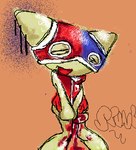
Meta: microsoft paint (artwork)
This tag is for artwork created, in whole or in part, using Microsoft Paint . For images depicting Microsoft Paint, see microsoft paint (copyright).
Colloquially known as MS Paint, Microsoft Paint is a simple graphics program that had been included with versions of Microsoft Windows from the release of Windows 1.0 in 1985. Due to its widespread availability, light weight, and almost total lack of a learning curve, it has been the first choice of beginning digital artists since its introduction. It garnered a reputation for producing extremely low-quality artwork, however, and its name has become virtually synonymous with such.
Nearly all images created in Paint are Binary Drawing, as Paint did not have any natively unaliased tools until Windows Vista.
- The first version, simply called PAINT.EXE, was bundled with Windows 1.0 through 2.0. It only supported 1-bit artwork, but includes several of the tools that it would become known for in later versions, such as the different pixel brush shapes. In lieu of a color palette, as full-color computer displays were still not commonplace at the time, its palettes consisted of 8×8 pixel grid patterns. It only supported saving in the .BMP file type.
- The second version, renamed to Paintbrush, was bundled with the Windows 3.0 and 3.1 lines. Though still primitive, it introduced a limited 16-color palette that expanded itself with dithering, much in the same way that other early nineties art software such as Mario Paint did. The familiar interface was also settled on at this time.
- The versions that came packaged with the Windows 9x series and Windows XP are largely similar to each other, with the latter version becoming the most famous and the version that is generally associated with the program as a whole. These are the versions that would earn MS Paint a reputation of being a cesspit of bad artwork. It contained numerous improvements over the previous version, including a full range of colors. However, its shortcomings began becoming clear. Against the rise of other graphics programs such as Adobe Photoshop, Paint's missing features in comparison began to it, such as working with layers as well as complex brushes and transformation tools, became obvious. Compression artifacts were also rampant, as saving in the lossy .JPG file type was not yet widely discouraged on the fledgeling World Wide Web (which did not exist for the majority of the 3.1 era). Most of what earned it its reputation at this time, however, was its having almost no barrier to entry nor learning curve; absolutely anyone could pick it up and intuitively use it. This included people who were children at the time, and children are not exactly known for being experienced artistic masters. Despite its weaknesses, however, it is still a capable tool for those who have the knowledge of art in general, especially in the realm of pixel art.
- Subsequent versions, such as those that came with Windows Vista, 7, and 8, would try to expand Paint's capabilities, but the damage that the previous version had done to its reputation at this point was virtually irreversible. It introduced more tools such as more detailed brushes, but it was still incapable of functions such as layers and transparency which had become commonplace at the time, and with alternative programs such as GIMP, as well as Paint.NET (envisioned as a direct replacement), becoming more widely available, it couldn't compete. Paint was briefly retired during the Windows 10 era in 2017, but an outpouring of nostalgia and general outcry led to this decision being reversed. Paint continued to be supported along with its intended replacement of Paint 3D.
- One final major update to the program was implemented in 2023 for Windows 11, finally adding long-requested features such as layer and transparency support. Paint 3D, once intended to dethrone it, was discontinued on November 4, 2024, and Paint once again became the primary default graphics program for Windows.
Older versions of MS Paint from 95 to 8 still function on Windows 10 and 11 if one can find and copy the files. The 1.x, 2.x, and 3.x versions can be run under their parent operating systems in DOSBox.
The following tags are aliased to this tag: microsoft_paint, ms_paint, mspaint (learn more).
This tag implicates digital_media_(artwork) (learn more).
Posts (view all)



